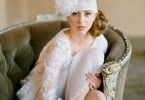Each journey begins with one step, and knowing what you want in your gown, will make yours all the more joyful! Do you have your gown made, or buy one off the rack? There are different styles to try on, a range of fabrics to choose from and a huge variety of stores to visit, whether on the street or online.
Plus, at the end of the day, not only does your gown have to fit you, it has to fit the not so fun-filled aspect of your wedding – the budget. With all this to consider, a little research before you get started will set you in good stead.
Rack it up
Buying off the rack can seem like a great idea if you’re running out of time, you’re short on cash, and you’re a standard ‘fit size’. It seems straightforward enough – if you like the garment and it fits, your work is done.
But despite how easy it sounds, off-the-rack purchases require a lot of thought. You’ll need to bear in mind that if the fit isn’t seamless to begin with there won’t be much room for alteration. In addition, not all off-the-rack dresses are created equal. The low price of bulk-manufactured gowns is usually indicative of synthetic fabric and lower-quality finishings, so if the price seems too good to be true its seams are intact, the beadwork’s not loose and it’s not shop soiled. On the other hand, designer off-the-rack dresses are of much higher calibre, also reflected in the price.
If you’re unsure what style you’re after, walking into a store stocked with hundreds of long white gowns can be intimidating. Pros advise phoning ahead to book some one-on-one time with a bridal consultant, and being open to donning a variety of styles.
Trying a range of gowns gives you a better feel for design and proportion than a sketch can; you get a feel for what looks good on you. Some brides say they don’t like the look of a dress on the hanger then fall in love with it as soon as they try it on.
Meet your maker
Employing a dressmaker may be the best option if you know exactly what you want, or you’ve been inspired by a celebrity style. That’s how it happened for Aucklander Jackie Robinson. ‘While looking at frocks worn on the red carpet, I spotted the one. Since I didn’t require any design input, I looked for a dressmaker who was also a talented pattern maker’ she explains.
Jackie’s dressmaker, Anita de la Cruz, says that the cost involved varies according to the work required.
A good dressmaker will be adept at bringing even the most ambitious ideas to life. ‘In over 40 years of dressmaking I’ve never made the same dress twice,’ says Anita. ‘Each and every dress is made to measure. Initially, I make the dress in calico, to allow the bride to make changes to the shape. The gown must fit like a glove, so getting it right might take five or six fittings, with the final fitting scheduled two to three weeks before the wedding.’
It’s an original
A couture gown is designed and tailored just for you. You’ll be able to choose everything from the style to the type of fabric. Since the sky’s the limit, so is the price tag.
For those who want to spend less but desire personalised service, some designers offer a made-to-measure range. While a dress is still made from scratch for the bride, and she can request unique details, the general style is already determined, therefore, the associated costs are reduced.
Pros advise brides to book a consultation up to a year in advance and schedule fittings six to eight weeks before the wedding date – although the fitting process can be shortened if time is of the essence.
The bigger picture
It’s easy to get carried away with wedding accessories – after all, it’s the only time over the age of five you can justify a tiara. But it’s vital to ensure that your accessories don’t compete with your dress. If all eyes on your gown, you’ll be able to skimp on shoes and you won’t need any jewellery. When accessorising, don’t wear a headpiece, intricate necklace and chandelier earrings all at once. One key accessory is usually enough to complete your look.
Making a specific statement with highly embellished or brightly coloured footwear is a popular trend. But if you’d like to match your footwear with your gown, ask your designer or shop salesperson for shoe dying recommendations.
Ever thine
If you want your gown to remain in pristine condition for years to come, you’ll need to preserve it properly. Take it to a trusted drycleaner soon after your celebration so stains don’t set in. Many offer a specialty service for bridal gowns with at least a one month turn around.
Once cleaned, avoid storing it in a plastic bag as chemicals can affect the fabric causing stains or ordours. Plastic also stops the fabric ‘breathing’, and encourages mould growth. Ask your designer or drycleaner for a gown preservation box. Line it with acid-free tissue paper and place more between the layers of the gown as you loosely fold it into the box. Store in a cool, dark place – under a bed or at the top of a cupboard is ideal.






